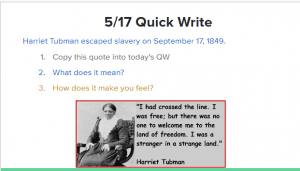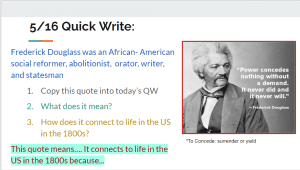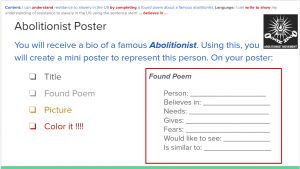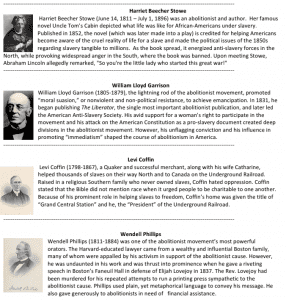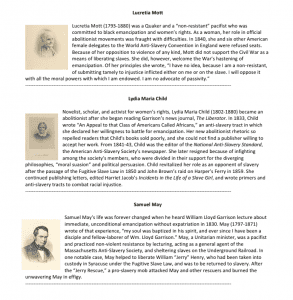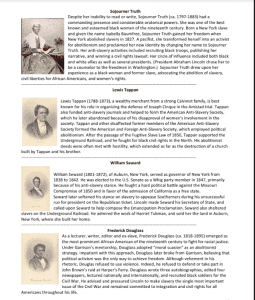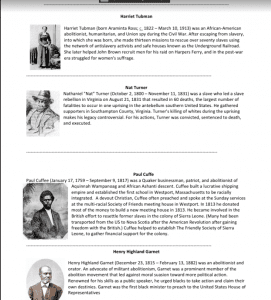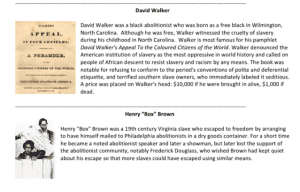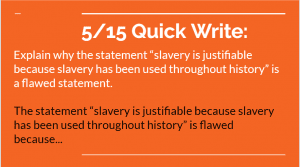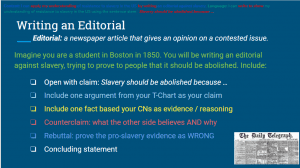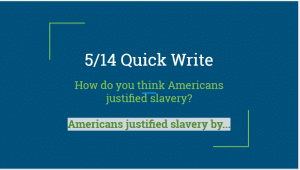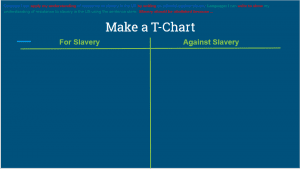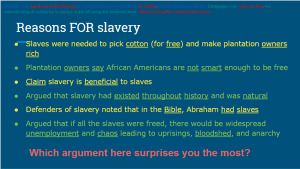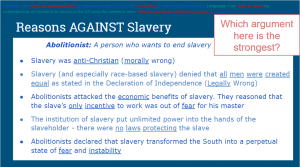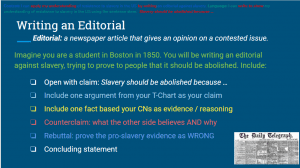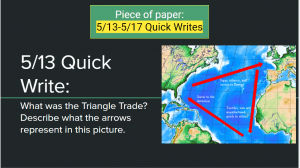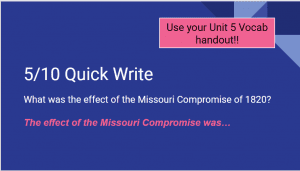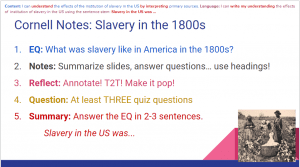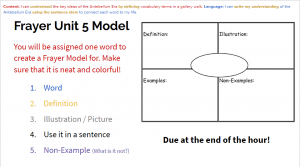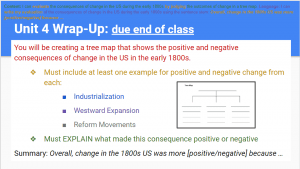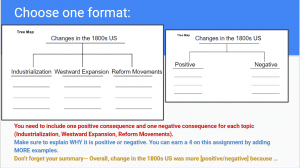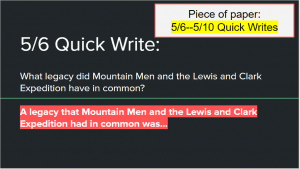Friday, May 17th!
Happy Friday!
5/17 Quick Write: I will be collecting FIVE Quick Writes today, and your LAST Current Event!
Today we are reviewing the institution of slavery with a quick video (he talks fast and covers a lot of info– focus on the stuff you already know and the information you recognize!)
After this review, we will do a gallery walk on the Found Poems of famous abolitionists. Find the handout here: Abolitionists Gallery Walk Notes
Out of the 21 activists, you will choose four poems and write down the following information for each:
- Who were they
- What did they do
- One interesting fact about them
The gallery walk should be completed by the end of the period.
Posted in Blogs by Kate Ulfers with no comments yet.
Thursday, May 16th
Hope testing was smooth and mostly painless!
5/16 Quick Write:
Reminder… Current Event due TOMORROW!
Today we are introducing ourselves to a handful of famous anti-slavery activists… abolitionists! All of these people had the same aim: to get rid of the institution of slavery. However, they used a wide array of techniques to achieve this goal– some were speakers and preachers, others put their message into typed words which were published in newspapers, and others organized and lead slave rebellions in an effort to free the south of slavery.
You will be given a short biography of one of 21 abolitionists, and with this information you will create a Found Poem (all of the info in the poem is FOUND in the bio). See the instructions, an example, and the poem template below.
Your Found Poem must be turned in at the end of class because they will be used in a gallery walk tomorrow.
Below are the 21 anti-slavery activists you may be assigned.
Posted in Blogs by Kate Ulfers with no comments yet.
Wednesday, May 15th– Late start!
No testing today, and a late start!
5/15 Quick Write:
Yesterday we documented the justification, or defenses, that people used both to keep slavery, and to abolish it.
Today, you are to write an editorial as if you were a student abolitionist in 1850. (Abolitionists, you’ll hopefully remember, are people who fight to get rid of the institution of slavery). Find the requirements and outline for the editorial below.
You have the whole class period to complete your editorial– put in quality effort and use your time wisely.
Reminder: Current Event due this Friday… last one!!
Posted in Blogs by Kate Ulfers with no comments yet.
Tuesday, May 14th!
Happy Tuesday!
As expected:
5/14 Quick Write:
In order to more fully understand the actions of many white Americans during the 1600-1800s, we need to analyze the justifications they used to “own” another human being. Today’s lesson will do just that: we will discuss the historical reasons FOR and AGAINST slavery. You will organize these justifications into a T-chart.
On the left side of your T-chart, write down the Reasons FOR slavery:
On the other side of the chart, write the Reasons AGAINST slavery:
After you have documented both rationales regarding slavery, you are to write an editorial as if you were a student abolitionist in 1850. (Abolitionists, you’ll hopefully remember, are people who fight to get rid of the institution of slavery). Find the requirements and outline for the editorial below.
Due to our shortened classes, this editorial will be homework tonight.
Have a RELAXING Tuesday!
Posted in Blogs by Kate Ulfers with no comments yet.
Monday, May 13th!
Welcome back!! We have NWEA testing in the morning, so our classes will be shortened today. Also, if you did not turn in a Current Event on Friday, make sure to get it in today!
Once again…
5/13 Quick Write:
We will wrap up our Cornell Notes on the institution of slavery today. On Friday we looked as several primary sources, including real photographs, newspaper ads and articles, and political cartoons/sketches. We also examined a map of the transatlantic slave trade (triangle trade) and a graph of population census data from the 1850s. All of these primary sources, and the accompanying conversations, addressed our essential question: “What was slavery like in America in the 1800s?”
You can find the primary sources and powerpoint slides here: Institution of Slavery Notes
You will hold on to these Cornell Notes as we will use them on our activity tomorrow.
Good luck with testing!
Posted in Blogs by Kate Ulfers with no comments yet.
Friday, May 10th!
Happy Friday!
We are continuing our conversation on the institution of slavery today. Therefore:
5/10 Quick Write: I am collecting FIVE Quick Writes today, and one Current Event!
Yesterday we reviewed the vocab words we will be using throughout this unit. Today, you will be taking Cornell Notes on the in-class lecture of what slavery looked like in the US. It’s understandable if this subject makes you uncomfortable. Please monitor how you react to this discomfort, as to not interfere with others’ learning.
You can find the lecture here: Institution of Slavery Notes
In you Cornell Notes be sure to summarize each slide, and answer the essential question: “What was slavery like in America in the 1800s?”
And, just to give us a brain break as we progress into the weekend… enjoy 🙂
Posted in Blogs by Kate Ulfers with no comments yet.
Thursday, May 9th:
Maturity Warning:
5/9 Quick Write:
As stated yesterday, we are discussing in detail a topic that needs to be taken seriously. The institution of slavery has been around for thousands of years, and intimately shaped the foundation of the United States of America. In order to understand our country as it functions today, we need to take a close and uncomfortable look at the actions taken by many white Americans against a huge group of people: enslaved people from Africa and their decedents. The intention of class today is for you to walk away with a more poignant and severe understanding of what the institution of slavery looked liked in America.
Today we will review the vocab terms we were introduced to yesterday. Then you will be taking Cornell Notes on the in-class lecture. You can find the lecture here: Institution of Slavery Notes
On you Cornell Notes be sure to summarize each slide, and answer the essential question: “What was slavery like in America in the 1800s?”
If you didn’t already, make sure to turn in your Unit 5 Vocab Frayer Model. Also, Current Event due tomorrow!
Posted in Blogs by Kate Ulfers with no comments yet.
Wednesday, May 8th:
Happy Wednesday! IF YOU ARE IN WASHINGTON DC, LOOK HERE FOR VOCAB DEFINITIONS!
5/8 Quick Write:
If you did not turn in your Unit 4 Wrap Up yesterday, turn it in today… it’s summative!
As we progress into Unit 5, we will be examining a very serious and heavy topic: the institution of Slavery. Therefore, it is crucial that you keep you class-comments in check and approach this subject in a reflective manner with the respect it is due.
As always when we start a new unit, we need to all be on the same page with the terminology we will use during discussions and lectures. To accomplish this, we will perform a gallery walk, filling out Unit 5 Vocab sheet: Unit 5 Antebellum Vocab Sheet
You can find the terms and definitions here! Antebellum Vocab Notes
At the end of the gallery walk, you will choose 1 vocab word and complete a Frayer model, including the following aspects:
- Word
- Definition
- Illustration / Picture
- Use it in a sentence
- Non-Example (What is it not?)
If you do not complete this Frayer Model in class, it will be assigned for homework.
Remember, you have a Current Event due on Friday!
Posted in Blogs by Kate Ulfers with no comments yet.
Tuesday, May 7th:
Time to wrap up Unit 4!
5/7 Quick Write:
Today we are discussing the last few reform movements we didn’t get to yesterday.
Then we are wrapping up Unit 4! We will be taking the three main topics of our unit– the Industrial Revolution, Westward Expansion and Reform Movements– and will create a Thinking Map showing both the positive and negative changes happening in the US during the 1800s. Please note, this is a SUMMATIVE grade, because you are showing me that you understand the content of Unit 4.
There are two types of Thinking Maps you can use (see below). Whichever you choose, you must show a negative and positive change of EACH of the topics we have covered: the Industrial Revolution, Westward Expansion and Reform Movements. You need a total of 6 changes.
Don’t forget the summary on the back of your Thinking Map: “Overall, change in the 1800s US was more [positive/negative] because … “
Time permitting, this is due at the END OF CLASS.
Reminder: Current Event due this Friday!
Posted in Blogs by Kate Ulfers with no comments yet.
Monday, May 6th!
Welcome back! Hopefully you absorbed some Vitamin-D this weekend and feel refreshed for this week.
5/6 Quick Write:
Here is our agenda for this week:
- Today: Reform Movements
- Tuesday: Wrap up Unit 4
- Wednesday: Intro to Antebellum Unit: Vocab gallery walk
- Thursday: The Institution of Slavery: Cornell Notes
- Friday: Justifications for Slavery: Abolitionist editorial
Be sure to turn in your Migrant Group CER! And if you did not turn in a Current Event on Friday, you need to turn one in today.
Today we are examining five Reform Movements that took place during the 1800s. We’ve already discussed how the Industrial Revolution and Westward Expansion were changing the economy and physical landscapes of America. Now we will focus our attention on how the social fabric of the country was also changing. We will examine 5 reform (change) movements:
- Temperance Movement
- Prison Reform Movement
- Education Reform Movement
- Abolitionist Movement
- Women’s Rights Movement
Today in class you will complete a Thinking Map: tree, brace or bubble.
In your Thinking Map you will take notes on the goals and leaders of each movement, as presented in class. You can find the Reform Notes here: Reform Movements Notes
Make sure to ask questions along the way, and focus on the similarities between all five movements!
Let’s have a very good week, aye?
Posted in Blogs by Kate Ulfers with no comments yet.
